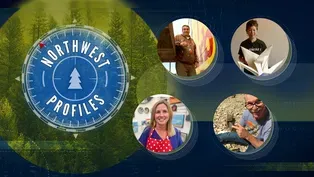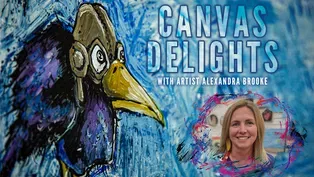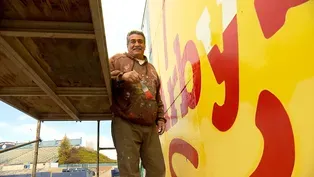Northwest Profiles
Expressive “Ori” “Kami”
Clip: Season 36 Episode 5 | 5m 46sVideo has Closed Captions
Patti Reiko Osebold forms art from folded paper and clay, in an age old Japanese artform.
Patti Reiko Osebold forms art from folded paper and clay, in an age old form of Japanese art.
Northwest Profiles is a local public television program presented by KSPS PBS
Funding for Northwest Profiles is provided by Idaho Central Credit Union, with additional funding from the Friends of KSPS.
Northwest Profiles
Expressive “Ori” “Kami”
Clip: Season 36 Episode 5 | 5m 46sVideo has Closed Captions
Patti Reiko Osebold forms art from folded paper and clay, in an age old form of Japanese art.
How to Watch Northwest Profiles
Northwest Profiles is available to stream on pbs.org and the free PBS App, available on iPhone, Apple TV, Android TV, Android smartphones, Amazon Fire TV, Amazon Fire Tablet, Roku, Samsung Smart TV, and Vizio.
Providing Support for PBS.org
Learn Moreabout PBS online sponsorshipIt was amazing to me how you can turn a square piece of flat paper into a three-dimensional, recognizable object.
just about every collage I have has a crane in it, whether it has a kimono, it also has a crane, whether it has a doll, it has a crane in it, because that's where everything started for me.
And plus, the crane has a very special meaning of peace and love.
And I think that's really important in everyone's life.
So, I just I make a lot of cranes, which makes me happy.
I'm Patty Reiko Osebold.
I was born in Honolulu, Hawaii.
And my parents, my dad's side was from Japan.
My mom's side was from Okinawa.
And my dad was born in Hawaii and my mom was born in California.
So, they got together and had me.
And growing up in my household, I used to see Japanese dolls, porcelain dolls made in Japan.
it never occurred to me that it was anything special.
It was just there.
And it wasn't 20 years later that I saw my first Japanese origami paper Crain, and this blew me away.
And it wasn't in Hawaii.
It was in Iowa, which always makes me chuckle because it's not the place you would think of seeing a paper Crain.
And that's where my story really started.
I became interested in doing origami and loved it.
Absolutely.
And this is 40 years later and I'm still doing origami.
There's many reasons why origami is important in everyday life.
When I had my stroke six years ago, I when I was in rehab at St Luke's, that's one thing I brought with me was paper.
And then I'd fold all the napkins and just fold them into different objects to strengthen my fingers.
And so, I had origami all on the ledge as the edge of my hospital room.
I've used it personally to rehabilitate myself.
My initial dolls were all paper dolls.
So, I went from paper because I wanted to show more movement.
I went from paper to clay, and I made and that's when I took a sculpture class.
I made the complete body of a person and then I put paper over it as their clothing.
And this is where my paper dolls are today.
I have a piece that I've called "homage to the Endangered and the Lost."
So, I made an art object out of the things that didn't turn out.
I keep adding to that.
So, it's a never-ending art piece.
I enjoy going to different schools.
And when asked and I will teach the kids how to do different things and show them what I have done and share with them my dolls and the meanings of them, as well as how to make a paper Crane.
Patience is a big deal, when I teach the kids how to make origami or something, they just suddenly get frustrated and want to rip up the paper and crush it up and throw it away.
And I tell them, you know, you have to do it over and over and over again.
And it does require a lot of patience.
But you come up with something so beautiful at the end and it teaches you patience and creativity also.
At the church I go to, we made a thousand cranes, and each of these cranes stand for peace, which is what we want...and love.
There is another part of this that has to do with my family now.
And World War two, my dad was in Pearl Harbor on duty at the time when the Japanese bombed Pearl Harbor and then my mom's family was in California, and they were taken into internment camps.
So, it's it has all a connection to me of this paper crane.
Me having the meaning of peace.
They made paper cranes in the internment camps and it it's just meaningful to me to know that this represents not only today what I'm doing, but in the past and the history.
And for me, that's very important.
Video has Closed Captions
Artists Alexandra Brooke, Patti Reiko Osebold, Ruben Marcilla and Stonerose Fossil site. (30s)
Canvas Delights: Alexandra Brooke
Video has Closed Captions
Artist & illustrator Alexandra Brooke shares her whimsical & delightful childlike painting (4m)
Video has Closed Captions
Ruben Marcilla has painted that walls of Avista Stadium in Spokane for over 30 years. (6m 49s)
Providing Support for PBS.org
Learn Moreabout PBS online sponsorshipNorthwest Profiles is a local public television program presented by KSPS PBS
Funding for Northwest Profiles is provided by Idaho Central Credit Union, with additional funding from the Friends of KSPS.















